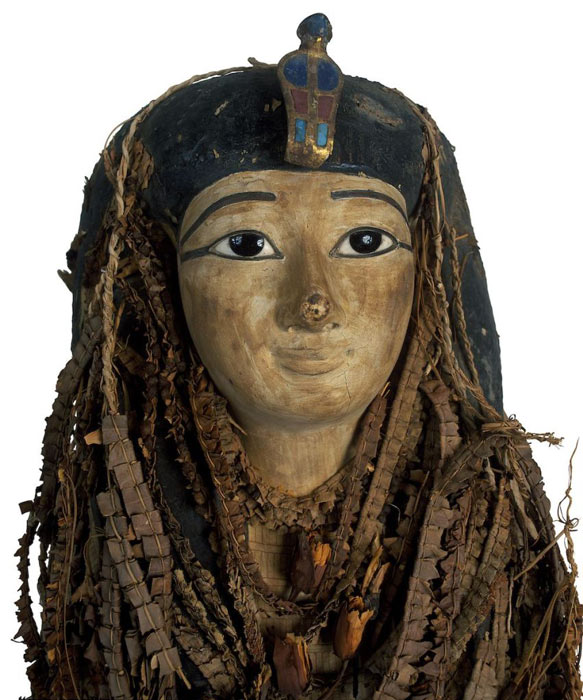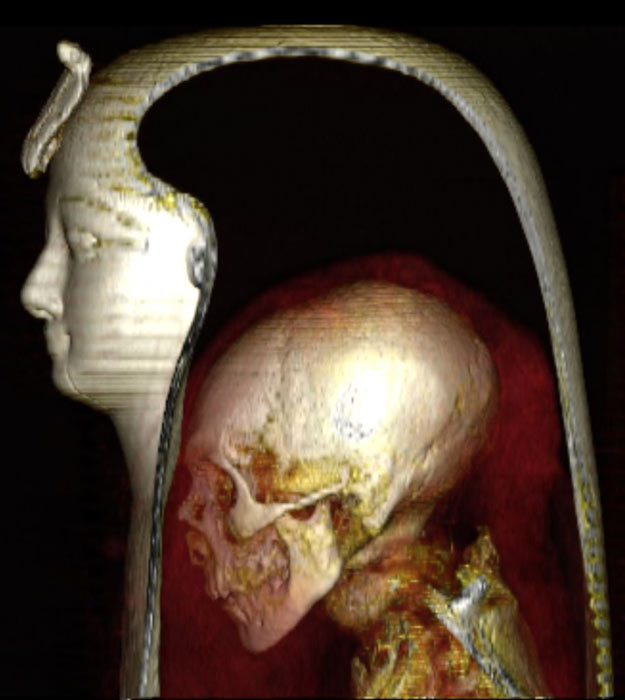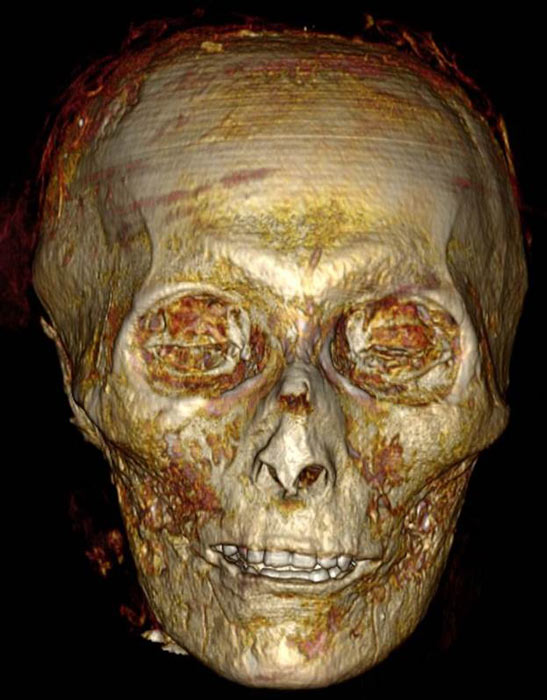
Digital Scan of Ancient Egyptian Mummy Amenhotep I Shows His True Face
The 3,500-year-old mummy of Egyptian pharaoh Amenhotep I had remained virtually unexamined since its discovery at Luxor, Egypt in 1881. As one of the few royal mummies from ancient Egypt yet to be unwrapped, it had revealed precious few details about the life of the man who ruled over a united Egyptian kingdom from 1525 to 1504 BC. But that situation changed dramatically, thanks to the development of an advanced digital scanning technology that let scientists “unwrap” Amenhotep I’s mummified remains without disturbing or damaging his physical coverings in any way.
Working in collaboration with the famed Egyptologist Zahi Hawass, University of Cairo radiologist Sahar Saleem completed a thorough and comprehensive digital examination of Amenhotep I’s mummified body. She used 3-D computed tomography (CT) scanning technology to obtain detailed imagery of the preserved bones and soft tissue, which eliminated the need to remove the mummy’s linen wrappings in order to see what lay beneath.
“Royal mummies of the New Kingdom [1550 to 1069 BC] were the most well-preserved ancient bodies ever found, so these mummies are considered a time capsule,” Saleem told the Guardian. “They can tell us about what the ancient kings and queens looked like, their health, ancient diseases, mummification techniques and manufacturing methods of funerary objects.”
In the case of Amenhotep I, the analysis revealed a long list of previously unknown details about his physical appearance, as Saleem and Hawass explain in an article about their study that was published in Frontiers in Medicine.

The outer mummy of pharaoh Amenhotep I which was digitally scanned to reveal a very clear picture of his head and body under all the bandages inside the sarcophagus! (S. Saleem and Z. Hawass / Frontiers in Medicine)
Amenhotep I Looked Like His Dad, Scientist Said
The mummy of Amenhotep I was one of the few remaining royal mummies from ancient Egypt that had yet to be extensively examined, either digitally or through a physical unwrapping. Egyptologists had always been reluctant to touch the mummy, which had been remarkably well preserved in high-quality linen covered by garlands made from safflowers, delphiniums, and Egyptian river hemp. The mummy also featured a striking and attractive painted burial mask that could have been permanently damaged if its linen had been removed.
Fortunately, digital technology has now advanced to the point where a digital scanning is actually superior to a direct hands-on examination. Saleem’s extensive analysis revealed a significant number of details about Amenhotep I’s physical characteristics, which had been largely unknown.
- A Dream Destination for Egyptologists: The Amazing Amarna Necropolis
- Egyptologists Set to Unravel the Identity of Mystery Pharaoh from Tomb KV55
“We show that Amenhotep I was approximately 35 years old when he died,” Saleem declared. “He was approximately 169 cm tall [5 ft 6 in], circumcised, and had good teeth.”
“Amenhotep I seems to have physically resembled his father,” she continued, referring to Ahmose I, the first king of the 18th Dynasty that ruled Egypt from 1,550 to 1,292 BC. “He had a narrow chin, a small narrow nose, curly hair, and mildly protruding upper teeth.” Amenhotep I’s brain was found intact, which is an unusual feature not shared with most other royal mummies.

Amenhotep I’s outer sarcophagus and his head and body after scanning inside. (S. Saleem and Z. Hawass / Frontiers in Medicine)
How a Respected King Was Rescued and Restored
The CT scans showed that Amenhotep I had been entombed with an impressive collection of valuable jewelry. Beneath his linen wrappings, his body had been decorated with approximately 30 amulets and a girdle constructed entirely from golden beads.
This latter fact was important, because it contradicted the beliefs of Egyptologists about the mummy’s previous history.
As revealed by hieroglyphics, in the 11th century BC Amenhotep I’s mummy had been removed from its original place of burial and relocated to Luxor. At this time the body was unwrapped and re-wrapped by priests, who’d been assigned to repair damage done by tomb raiders. In Luxor the mummy was entombed alongside the mummified bodies of other kings or aristocrats, all of whom had been saved from the relentless depredations of thieves seeking treasure.
Egyptologists had long suspected that the priests assigned to complete the restoral of Amenhotep I’s body had participated in some thievery themselves. It was thought they’d likely removed any jewelry they’d found on Amenhotep I’s body, before finishing the re-mummification process that would have hidden the truth about their deception.
But the results of the CT scans have cleared the ancient 11th-century priests of any wrongdoing.
“We show that at least for Amenhotep I, the priests of the 21st dynasty lovingly repaired the injuries inflicted by the tomb robbers, restored his mummy to its former glory, and preserved the magnificent jewelry and amulets in place,” Saleem said. Ultimately, it was the work of these priests that made Saleem’s new study possible, since they were the ones who took action to ensure his body would remain preserved in a pristine and authentic state.

The full facial reconstruction of pharaoh Amenhotep I is eerie and still leaves us wondering what his life really was like and who he really was. (S. Saleem and Z. Hawass / Frontiers in Medicine)
Who Was Amenhotep I? Scholars Still Know Little
Amenhotep I ruled New Kingdom Egypt during a time of relative peace and prosperity. His father Ahmose I had successfully reunified the kingdom in 1,550 BC, defeating the Hyksos who had seized control of Lower Egypt (Ahmose’s Theban royal house ruled Upper Egypt).
With the restoration of total Theban control over the entire country, Ahmose I founded the 18th Dynasty, and the New Kingdom along with it. By the time Amenhotep I took the throne 25 years later, the military campaigns that led to reunification had largely been completed. Presumably, this would have allowed the new ruler to concentrate his energies on administrative reforms and temple building projects.
- The Mystery of King Tut’s Death Finally Solved?
- CT Scan Conducted on 2,000-Year-Old Mummy Reveals the Cancer that Killed Him
The five centuries of New Kingdom rule have been recognized by historians as one of the “Golden Ages” of ancient Egypt. The kingdom was prosperous and faced few serious external or internal threats during this time, and Amenhotep I undoubtedly benefited from these circumstances. Very little is known about what kind of ruler he actually was, although it appears he was successful in maintaining the structure that his father created during his twenty years of rule.
Despite the many fascinating revelations her study of his mummified remains produced, Sahar Saleem was unable to discover was exactly how Amenhotep I died.
“We couldn’t find any wounds or disfigurement due to disease to justify the cause of death, except numerous mutilations postmortem, presumably by grave robbers after his first burial,” she explained.
This raises the possibility that Amenhotep I was poisoned to death, or otherwise killed in a way that would have left no physical scars or damage. Then again, he may simply have died of natural causes. Unless hieroglyphic texts are eventually found that address the mystery, there is no way to know for sure what happened to this still relatively obscure ancient Egyptian pharaoh.
Top image: Scientists digitally scanned the sarcophagus of pharaoh Amenhotep I to reveal a stunning image of his actual head and body. Source: S. Saleem and Z. Hawass / Frontiers in Medicine
By Nathan Falde















